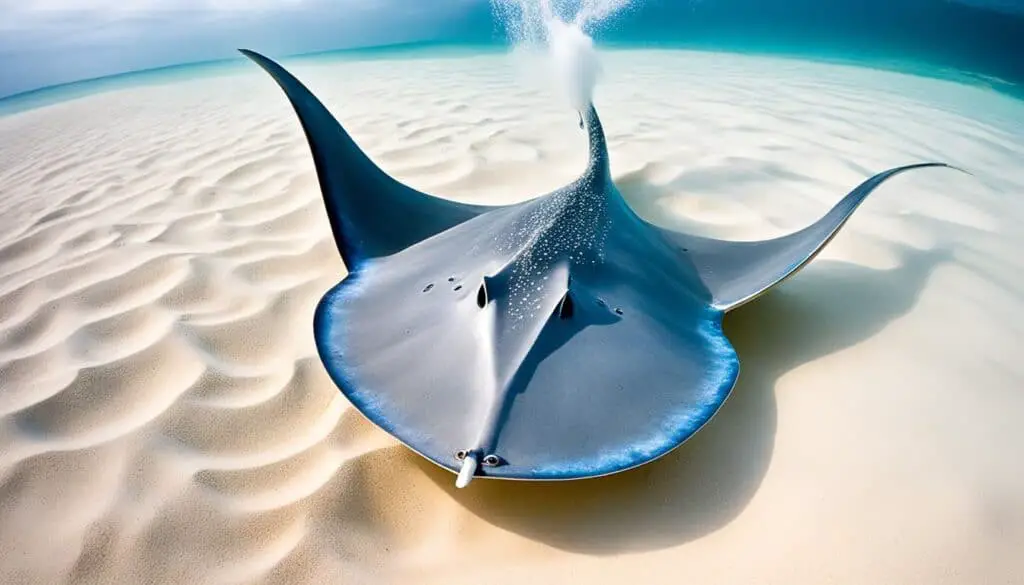Have you ever wondered how stingrays find their meals in the ocean? These amazing creatures are skilled hunters, well-suited to their underwater world. They have special features and use different ways to find and catch their food, mostly small fish and crustaceans. Let’s explore their unique traits and how they hunt in this article. We’ll also look at what they like to eat and the challenges they face in their environment. Come with us as we learn about the fascinating hunting ways of stingrays.
Understanding Stingray Anatomy and Feeding Mechanisms
Stingrays have an interesting anatomy that helps them eat in different marine places. Their body shape lets them live in various environments and catch food well. Let’s look at two important parts of their body that make them good hunters.
The Unique Structure of Stingray Jaws
The stingray’s jaws are made of cartilage, unlike many other fish. This makes them flexible. They can break open hard shells of mollusks and crustaceans. Their jaws have many layers and hollow parts, giving them both strength and quickness to eat.
This special jaw design helps them eat hard food and handle their food carefully.
Role of Sensitive Ampullae of Lorenzini
Stingrays have the ampullae of Lorenzini, which are special pits on their snouts filled with gel. These pits can sense tiny electrical signals. This is key for finding prey hidden under sand or in unclear water.
Being able to feel electrical signals helps stingrays hunt even when they can’t see well. This gives them a big advantage in finding food.
How do stingrays hunt for food?
Stingrays have amazing hunting skills. They use different strategies to catch their prey. This helps them be top predators in their home.
Camouflage Techniques on the Ocean Floor
Stingrays often hide using camouflage. Their flat bodies let them sink into the sand. This makes them hard to see from above.
They cover themselves with sand to hide. This way, they can wait for fish or crabs to come by. Being a surprise helps them catch their prey.
Use of Electric Detection in Hunting
Stingrays also use electric detection to hunt. They have special organs called the Ampullae of Lorenzini. These organs help them feel the tiny electrical signals from prey.
Even when hidden under sand, they can find fish or crabs by sensing these signals. This mix of hiding and sensing helps stingrays catch their food easily.

Stingray Feeding Habits and Diet
Stingrays have a unique way of catching food in the ocean. They eat a diet rich in marine life, mainly from the ocean floor. Their diet includes crustaceans, small fish, mollusks, and other bottom-dwelling creatures.
Common Prey: Crustaceans and Small Fish
Stingrays hunt a variety of prey that are key to their diet. Their main targets are:
- Clams
- Oysters
- Shrimp
- Small fish such as gobies and silversides
These foods are common in coastal areas. This makes it easy for stingrays to feed using their special feeding methods.
Feeding on the Ocean Floor: A Closer Look
Stingrays have a unique way of finding food on the ocean floor. They move along the bottom, using their mouths to pick up prey. This shows how well they adapt to life on the bottom of the sea.
Stingray Foraging Methods Explained
Stingrays have unique ways of hunting in the ocean. They use ambush hunting and group hunting to catch their prey. These methods show how smart and diverse their hunting skills are.
The Art of Ambush: Hunting in the Sand
Stingrays are experts at ambush hunting. They hide under the sand, making them hard to see. When prey comes close, they jump up fast to grab it. This way, they use less energy and catch more food.
Group Hunting Behaviors in Manta Rays
Manta rays hunt together in groups. They work as a team to catch their food. This teamwork helps them catch more food, showing how smart they are.
| Foraging Method | Description | Benefits |
|---|---|---|
| Ambush Hunting | Stingrays lie hidden in the sand, waiting for prey. | Energy-efficient approach with high success rate. |
| Group Hunting | Manta rays hunt in schools to corral prey. | Increases capture efficiency through teamwork. |
| Camouflage | Blending with the ocean floor for stealth. | Reduces visibility to potential prey. |
Adaptations for a Successful Hunt
In the vast underwater world, stingrays have amazing adaptations that make them great hunters. Their flat bodies let them hide in sandy areas, keeping them safe from both prey and threats. This shape helps them blend in and ambush prey easily.
Stingrays move smoothly through the ocean floor with their wide bodies. They can hide and strike without being seen.
Flat Body Design for Burrowing and Concealment
The flat body of stingrays is key to their hunting. They can hide under the sand, waiting for prey to come close. This way, they avoid being seen by bigger predators.
Stingrays use this hiding skill often. Their body shape helps them catch prey and stay safe.
The Importance of Sensory Adaptations
Stingrays also have special senses that help them find food. They have electroreceptors called Ampullae of Lorenzini. These let them feel electrical signals and vibrations in the water.
This helps them find hidden food. With their senses and hunting skills, stingrays are top predators in the ocean.
FAQ
How do stingrays hunt for food?
Stingrays hunt using camouflage. They hide on the ocean floor, making them hard to see. They also use their Ampullae of Lorenzini to find prey by sensing electrical signals.
What is the role of stingray anatomy in their feeding habits?
Stingrays have jaws made of cartilage that help them crush shells. Their jaws and the Ampullae of Lorenzini make them better at finding and eating prey.
What types of prey do stingrays typically eat?
Stingrays eat small fish, crustaceans, and mollusks. They mostly eat creatures from the ocean floor. This shows how well they fit into their underwater homes.
Can you explain the different foraging methods used by stingrays?
Stingrays use ambush hunting. They hide under the sand and surprise their prey. Some stingrays, like manta rays, hunt together, which helps them catch more food.
How does the flat body design of stingrays aid in hunting?
Stingrays can easily hide in the sand with their flat bodies. This helps them avoid predators and sneak up on prey. Their hunting ways make them good at catching food.
What sensory adaptations contribute to stingray hunting success?
Stingrays have the Ampullae of Lorenzini to sense electrical fields and vibrations. These help them find prey even in murky water.







